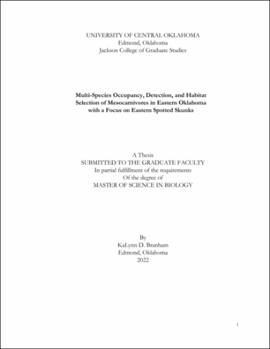| dc.contributor.advisor | Jackson, Victoria | |
| dc.contributor.author | Branham, KaLynn D. | |
| dc.date.accessioned | 2022-08-24T19:36:17Z | |
| dc.date.available | 2022-08-24T19:36:17Z | |
| dc.date.issued | 2022 | |
| dc.identifier.other | (AlmaMMSId)9982877910602196 | |
| dc.identifier.uri | https://hdl.handle.net/11244/336506 | |
| dc.description.abstract | The eastern spotted skunk (Spilogale putorius) was once a commonly occurring species and was regularly harvested for fur. In the mid-20th century, this species experienced a drastic and sudden decline which prompted conservation agencies to designate it as a species of conservation concern throughout its range. Range-wide studies have been occurring with the goal of gathering accurate distribution data on the species in order to understand more about the decline and determine reliable conservation strategies. In an effort to contribute data regarding their distribution and habitat presence in Oklahoma, I used camera traps to survey the Ouachita National Forest and Cookson Wildlife Management Area in eastern Oklahoma. Although my observations of the species were limited, I was successful at recording the presence of eastern spotted skunks in Oklahoma along with many other fur-bearing mesocarnivore species including coyotes (Canis latrans), gray foxes (Urocyon cinereoargenteus), bobcats (Lynx rufus), northern raccoons (Procyon lotor), Virginia opossums (Didelphis virginiana), and striped skunks (Mephitis mephitis). I discovered that most of the additional species were underrepresented in population studies and conservation reports. Being that they are subject to legal harvest, it is important to emphasize the significance of achieving a more accurate understanding of population demographics for legally harvested furbearers in Oklahoma. It is also important to provide a basis for conducting regular species detection efforts for the state using camera traps and occupancy modeling. In addition, I conducted a human dimensions survey to understand public perception and attitudes toward mesocarnivores from residents living in eastern Oklahoma, and I used that opportunity to gather additional eastern spotted skunk location data that may be important for future distribution studies. | en_US |
| dc.rights | All rights reserved by the author, who has granted UCO Chambers Library the non-exclusive right to share this material in its online repositories. Contact UCO Chambers Library's Digital Initiatives Working Group at diwg@uco.edu for the permission policy on the use, reproduction or distribution of this material. | |
| dc.subject.lcsh | Eastern spotted skunk | |
| dc.subject.lcsh | Oklahoma | |
| dc.subject.lcsh | Ecology | |
| dc.subject.lcsh | Conservation | |
| dc.subject.lcsh | Mammal populations | |
| dc.subject.lcsh | Habitat selection | |
| dc.subject.lcsh | Fur-bearing animals | |
| dc.subject.lcsh | Public opinion | |
| dc.title | Multi-species occupancy, detection, and habitat selection of mesocarnivores in eastern Oklahoma with a focus on eastern spotted skunks | en_US |
| dc.type | Academic theses | |
| dc.contributor.committeeMember | King, Chad | |
| dc.contributor.committeeMember | Fullerton, Matt R. | |
| dc.thesis.degree | M.S., Biology | |
| dc.subject.keywords | Camera trapping | |
| dc.subject.keywords | Eastern spotted skunks | |
| dc.subject.keywords | Furbearers | |
| dc.subject.keywords | Human-dimensions | |
| dc.subject.keywords | Occupancy modeling | |
| dc.subject.keywords | Spilogale putorius | |
| dc.subject.keywords | Wildlife conservation | |
| dc.subject.keywords | Wildlife management | |
| dc.identifier.oclc | (OCoLC)1342443048 | |
| thesis.degree.grantor | Jackson College of Graduate Studies | |
